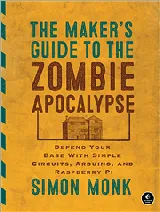
The Maker's Guide to the Zombie Apocalypse

Posted: January 18, 2016 | | Categories: Miscellaneous
I recently received a copy of Simon Monk's The Maker's Guide to the Zombie Apocalypse. I'd read several of Simon's books (Programming the BeagleBone Black and Make: Getting Started with the Photon). I've enjoyed his books, and they've helped me learn how to work with the Photon and BeagleBone Black.

I travel a lot and when I'm trying to learn something, I prefer to pick up a book and work through the book step by step. Online documentation is OK, especially when you're trying to find a quick fix to something, but I find that books are better at the overall learning you need when you first start working with a hardware device, developer tool or programming language. There's something about the structure of a book vs. poking around in product documentation that makes it easier for me to learn from a book.
This book is different – instead of working with a specific hardware device, he's picked a theme for this one and targeted all of the book's projects to that theme. In this case, it's all about some projects you can do that will help you survive the Zombie Apocalypse (ZA). Overall, he's done a good job in selecting useful projects and connecting them well with the theme. The good news is that even though he's working with a theme, and having some fun with the whole Zombie aspect of it, he doesn't overdo it. The ZA attitude and the jokes that accompany it are fun and not overdone. I especially liked the web cam example image that included a Zombie in it – a nice and fun touch.
The good thing about this themed approach is that he's crafted a series of useful projects then tied them together with a single management console. Each project can be built separately, but when you follow the theme and get them all working together through the console, you get a feel for how more complicated projects can work.
Since he's focusing on a series of projects and not a specific hardware device, you get to see how to implement projects on different hardware platforms (Most projects are on the Arduino, but the Raspberry Pi shows up as well).
Unfortunately, his parts lists don't take into account that you might not be adding a particular project to another existing project that already has some parts. I found myself looking at the shopping list and thinking that things were missing only to discover later that he's expecting this particular project to be added to another. I would have preferred a complete list of parts that were somehow marked to indicate “You may already have this part if you're adding this to that other project.” It's not a big deal, but it did cause me some pause as I tried to figure out which parts were needed to complete the whole project.
The thing I liked the most about this book compared to the others I'd read is the length of the book. Since he wasn't doing a quick hit on a specific hardware device, he spent more time (pages) covering the background material in detail before showing how to make the report. I especially liked the chapter on survival tips for the ZA: Chapter 1 – Apocalypse Basics. In this chapter he covers some basic survival requirements before jumping into the skills you need to make the projects. In the second chapter, he talks about how to generate electricity and provides a lot of good background about electricity and battery life. The value of this for many readers will be when they're trying to build something with similar (but different parts); the material he provides makes it easy for the reader to figure out how his stuff will work compared to what Monk shows in the book. He did a really good job showing how to make use of the flash in a pile of discarded (empty) disposable cameras.
Of all the microcontroller projects book I've read (and I've read a bunch), this book had more practical material (background and project) than most others. There are real world applications for each of the projects described herein. Additionally, the none of the projects were that hard, I knew I had the skills for each. I'm looking forward to see what he does next.
Next Post: What's Wrong With Trolling
Previous Post: Outlook Populating Country Only in Contact
If this content helps you in some way, please consider buying me a coffee.
Header image: Photo by Marcos Paulo Prado on Unsplash